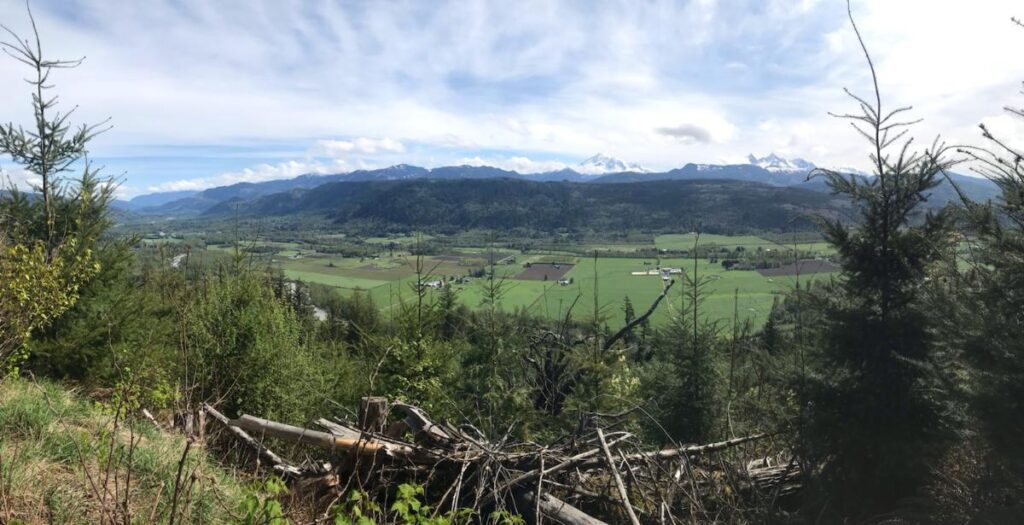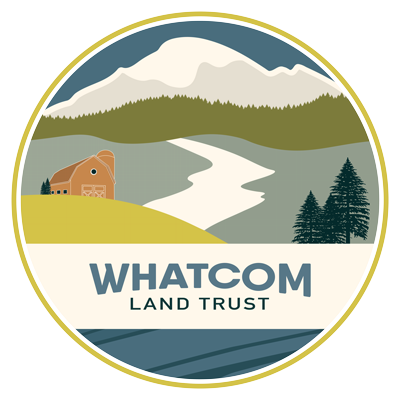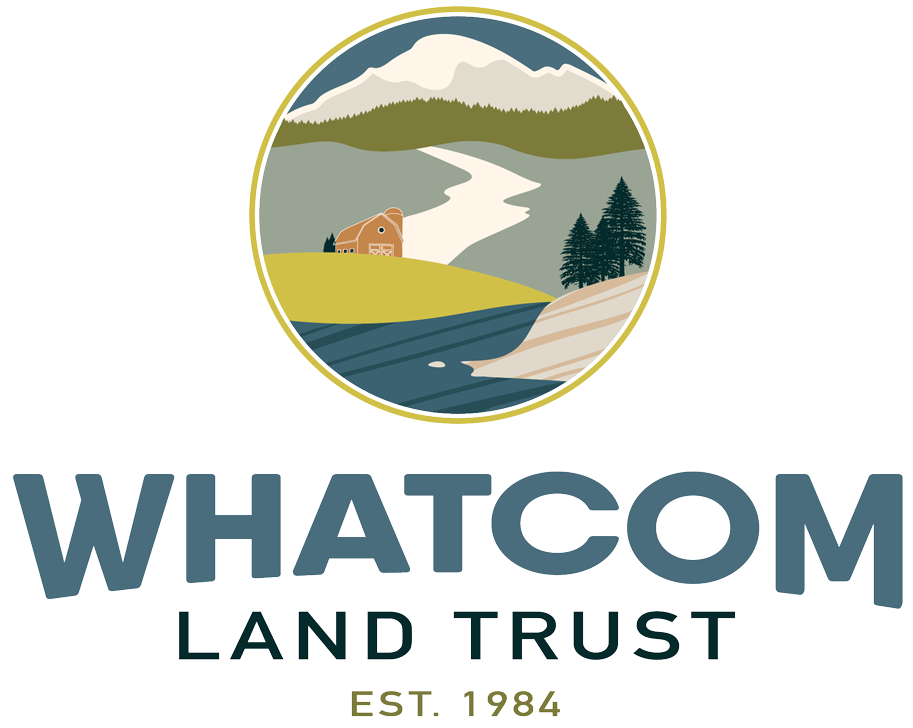“The First 550” of Stewart Mountain Community Forest

Since 2014, staff and community members from the Nooksack Tribe, Whatcom Land Trust, Whatcom County, Evergreen Land Trust and South Fork Valley citizens have been collaborating to push forward the Stewart Mountain Community Forest Initiative—a community partnership with an ambitious plan key to saving salmon in the South Fork Nooksack River. Their plan–to adopt and manage locally 5,500 acres of forest on Stewart Mountain with a focus on local benefits.
The first phase of that plan reached a major milestone on June 7, 2022, when the Whatcom County Council approved allocation of $1.5 million from the Conservation Futures Fund via the County Executive’s office for the purchase of the first 550 acres from a New Hampshire-based timber company. The total purchase price of $2.3 million will include $300,000 from Evergreen Land Trust via a grant they received from Whatcom Community Foundation and Whatcom Land Trust has committed to an additional $550,000. Whatcom Land Trust will own and manage the stewardship of the property and Whatcom County will hold the conservation easement that will protect the property long-term.
“The Stewart Mountain Community Forest provides an opportunity to demonstrate how we can manage large scale working lands for economic as well as ecological benefits with more local control and input from community partners,” says Whatcom Land Trust Executive Director Gabe Epperson.
Stewart Mountain Community Forest would benefit the community by restoring watershed health in the South Fork Nooksack Valley, strengthening the local forest economy, ensuring permanent access for tribal cultural uses, and developing recreational and educational opportunities.
Where is Stewart Mountain?
Located on the ancestral homelands of the Nooksack Indian Tribe in the South Fork Nooksack River Valley, Stewart Mountain is on the east side of Lake Whatcom in rural Whatcom County, overlooking the communities of Deming, Van Zandt, Acme, Wickersham and across Lake Whatcom to Sudden Valley and Bellingham.
From the vantage point of downtown Bellingham, when looking toward Mount Baker, the 3,000-foot Stewart Mountain is in the foreground. The forest is a patchwork of mature forests, some young, rapidly regenerating tree stands and more recent clearcuts.
What is a Community Forest?
A community forest is a forest owned and managed to provide secure and reliable access to ecological, economic, and community benefits produced and provided by the forest. In this model, the community partners play a significant role in decision making around how the forest and its resources are managed and used.
The Nooksack name for the South Fork, and the village that once existed at its mouth, is Nuxw7íyem, or always-clear water. Unlike the North and Middle Forks of the Nooksack River, the South Fork is not fed by icy, cloudy glacial melt. So, its waters are lower, warmer and more susceptible to the impacts of heat waves and a shifting climate.
Changes in the South Fork are also affecting the valley’s human inhabitants. “We have been working for over 25 years with our neighbors to protect this land, both because of how rare this ecology is, and also because of the landslides and debris flows that have happened because of industrial logging practices above our homes,” explains Holly O’Neil of Crossroads Consulting who has been involved in the initiative. “It is clear that we need a different kind of forest management on Stewart Mountain, that reflects what we know now about how to sustain jobs in the woods, and improve water, soil, and habitat conditions. There are lots of great examples for how to do it, and we can be a model for other communities.”
The hot summer of 2021 worsened conditions for the Puget Sound Chinook salmon, federally listed as a threatened species since 1999. They have come closer to extinction in the South Fork than in any other river in their range. In September 2022, at least 2,500 Chinook salmon died in the South Fork before they could spawn due to heat-loving bacteria in the low-flow river.
To address these and other concerns, the Tribe has developed an action-based climate adaptation plan in partnership with the University of Washington’s Climate Impacts Group. The formation of Stewart Mountain Community Forest is just one of many actions the Tribe is taking to mitigate climate impacts on the South Fork.
“Nobody told us to do this work,” said Oliver Grah, the Nooksack Tribe’s former water resource director who recently retired, in a January 2022 article. “We just saw climate change being one of the biggest threats to the Tribe’s ability to harvest treaty resources in the future and you can’t wait for the impacts to get worse to do anything about it, you have to start now.”
“Stewart Mountain Community Forest was identified as one of the most significant projects to increase stream flow in the South Fork,” says Whatcom County Senior Planner Chris Elder. “This is a good project to demonstrate commitment to improving watershed health and still maintaining working forest land. We’re excited to pilot out some active management techniques and work with the forest industry and our local watershed partners for a very collaborative project.”
Timber management on the Stewart Mountain property will protect old-growth and mature forest stands, and implement selective tree harvest rather than clear-cuts. This will reduce the acreage of young, regenerating forests that release more water to the atmosphere than mature and old growth stands. Older trees will suck up less water for transpiration than expansive rapidly regenerating stands, and thereby increase streamflow in the South Fork.
What’s Next
“Acquiring this first 550 acres of forested hillside along the South Fork is an important step toward realizing meaningful impacts for habitat and working forests in the watershed,” says Whatcom Land Trust’s Conservation Director Alex Jeffers. “The communities on and around Stewart Mountain will keep working together to realize the next phases of their vision for the 5,500-acre Community Forest.”
This first acquisition of 550 acres is expected to close in August 2022.
“The key difference with this project is that we’re proposing to keep it actively managed for forestry. The County has never owned property and been a contributing working land provider of services,” explains Elder. “So this is new ground for us so we’re looking to have lots of additional engagement with our County Council. At the end of the day, we’re trying to combine active management and watershed enhancement and achieve both in one project.”
These community partners will continue to collaborate to develop plans that will focus on acquisition of the remaining 4,950 acres over the next five to ten years.
Whatcom Land Trust is asking for your support now to help raise $140,000 to support the long-term stewardship of this first 550 acres of an ecologically and geologically sensitive part of Stewart Mountain. Whatcom Land Trust is asking you to support the stewardship and sustainable management of these lands and help us realize the vision for Stewart Mountain conservation. Contribute at www.whatcomlandtrust.org.
More About Whatcom Land Trust
Whatcom Land Trust preserves and protects wildlife habitat, scenic, agricultural and open space lands in Whatcom County for future generations by securing interests in land and promoting land stewardship. Over 24,000 acres in Whatcom County have been permanently protected since 1984, including 1,300 acres of working agricultural lands, 14,000 acres of parkland, 47 miles of marine and freshwater shorelines, and 12,500 acres of forestland and stream buffer in the Lake Whatcom Watershed.
Contacts:
Alex Jeffers, Conservation Director
Whatcom Land Trust
Alex@whatcomlandtrust.org
330-931-6321
Chris Elder, Senior Planner
Whatcom County
celder@co.whatcom.wa.us
360-778-6225
Holly O’Neil
Evergreen Land Trust
Holly@crossroads.pro
Ian Smith
Cascadia Farm and Forestry, LLC.
cascadiafarmandforestry@gmail.com


